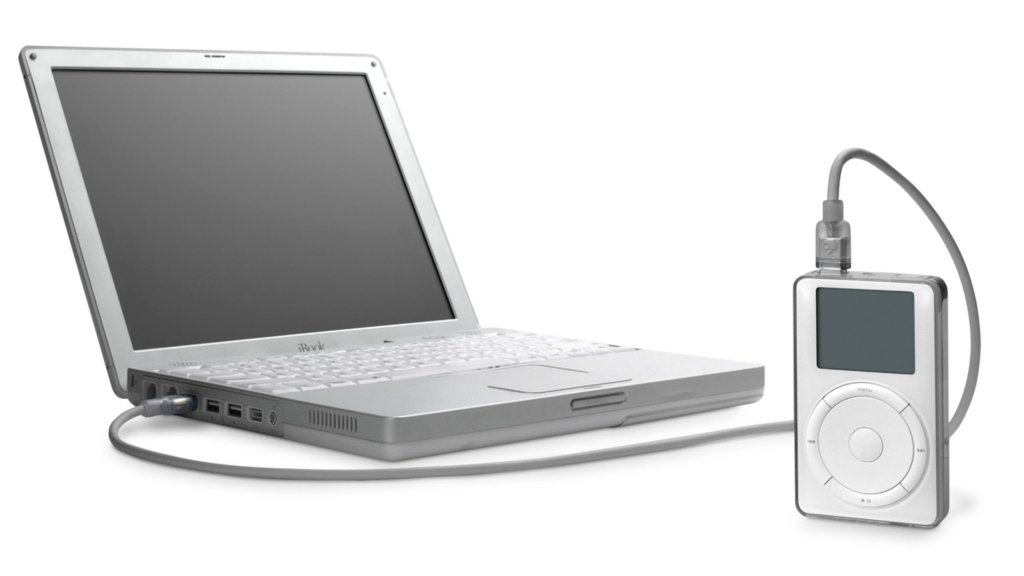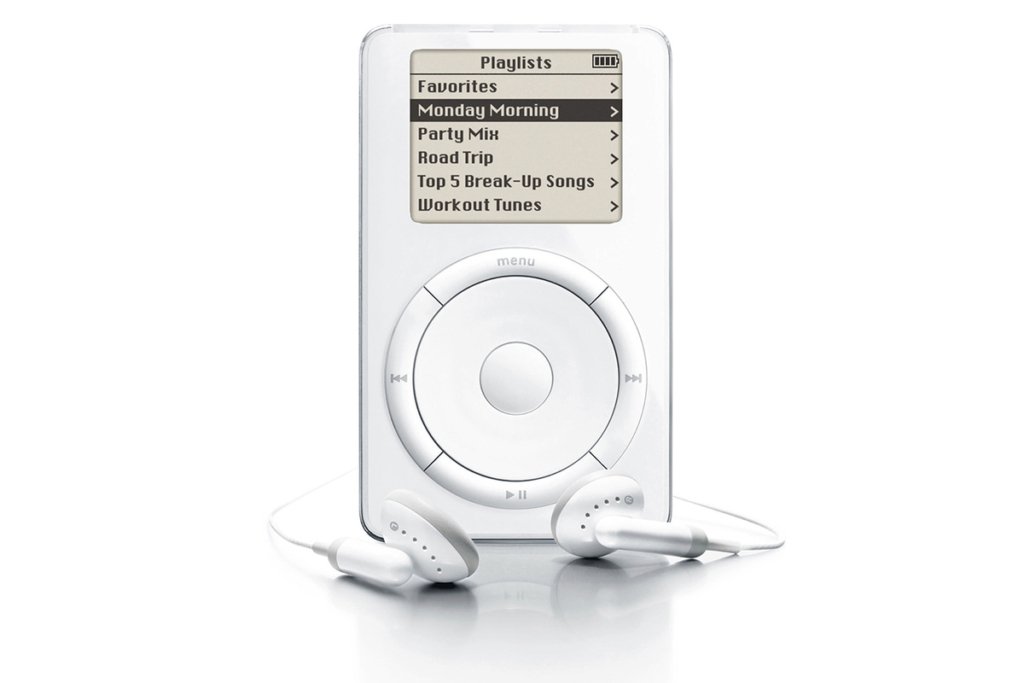On October 23, 2001, Apple unleashed a game-changing innovation that would redefine the way we experience music—the Original Apple iPod also known as “Scroll Wheel” or “1st Generation”. A portable MP3 player that marked the dawn of a new era in personal entertainment and paved the way for a technological revolution.
Apple’s introduction of the first iPod represented a quantum leap in portable music players. Designed with meticulous attention to detail, the iPod packed up to 1,000 CD-quality songs into a sleek 6.5-ounce device that could effortlessly fit into your pocket. This innovation marked a significant departure from traditional methods of music consumption, setting the stage for a paradigm shift in personal entertainment.
A key highlight of the iPod was its Auto-Sync feature, a revolutionary technology that simplified the process of managing music collections. Auto-Sync automatically downloaded all your iTunes songs and playlists onto the iPod, ensuring that your music library was always up to date. This seamless integration with iTunes made managing your digital music effortless, setting the iPod apart as a user-friendly and intuitive device.
The iPod wasn’t just a music player; it was a technological marvel. With a 5 GB hard drive, it could store up to 1,000 CD-quality songs—unheard of in its time. Despite its compact size, the iPod featured up to 20 minutes of shock protection, making it an ideal companion for active individuals engaging in activities like running or biking.
The built-in FireWire port was another game-changer, allowing users to download an entire CD into the iPod in under 10 seconds and 1,000 songs in less than 10 minutes—30 times faster than USB-based players. The iPod’s rechargeable lithium polymer battery powered up to 10 hours of continuous music and recharged automatically when connected to a Mac using the FireWire cable.

Apple’s commitment to delivering top-notch audio quality was evident in the iPod’s specifications. Supporting popular formats like MP3, MP3 VBR, AIFF, and WAV, the iPod featured a high-output 60-mW amplifier for CD-quality sound. The earbud-style headphones, equipped with neodymium magnets, ensured enhanced frequency response and high-fidelity sound.
The 160-by-128-pixel high-resolution display with a white LED backlight was a testament to Apple’s dedication to providing users with a clear and immersive visual experience. Whether in broad daylight or low-light conditions, the iPod’s display offered unmatched visibility.
Apple’s reputation for user-friendly interfaces extended to the iPod with Scroll Wheel. The unique scroll wheel design allows users to navigate their entire music collection effortlessly, with automatic acceleration for quick scrolling through extensive lists. Customizable settings, such as shuffle, repeat, startup volume, sleep timer, and multilingual menus, provided a personalized user experience.
The Auto-Sync feature of the iPod revolutionized the way users managed their music libraries. Simply connecting the iPod to a Mac with the FireWire cable initiated the automatic download of all iTunes songs and playlists. This not only simplified the process but also ensured that users had their latest music and playlists whenever they plugged in their iPod, usually in a matter of seconds.
The first-generation iPod hit the market on November 10, 2001, with a suggested retail price of $399. Available through The Apple Store, Apple’s retail stores, and Apple Authorized Resellers, the iPod came bundled with an iTunes 2 CD, earbud-style headphones, a FireWire cable, and a FireWire-based power adapter. To fully experience the magic of the iPod, users were required to have iTunes 2.
Despite its eventual discontinuation on April 28, 2003, the original iPod remains a pivotal piece of technology in the history of personal entertainment. With its sleek design, innovative features, and user-friendly interface, the iPod laid the foundation for future generations of portable music players. As we reflect on its impact 22 years later, the iPod stands as a testament to Apple’s commitment to pushing the boundaries of technology and enhancing our everyday lives.

iPod with Scroll Wheel Details
| Introduced | October 23, 2001 (5 GB) March 21, 2002 (10 GB) |
| Discontinued | July 17, 2002 (10 GB) April 28, 2003 (5 GB) |
| Model Number | M8541 |
| EMC | 1910 |
| Order Number | M8513LL/A (5 GB) M8709LL/A (10 GB) |
| Original Price | $399 (5 GB) $499 (10 GB) |
| Colors | White |
| Weight | 6.5 oz. 184 Grams |
| Dimensions | 4.02” H x 2.43” W x 0.78” D 10.21 cm H x 6.17 cm W x 1.98 cm D |
Original iPod Tech Specs
Processor
| Processor | PortalPlayer PP5002 (Dual ARM 7TDMI) |
| Processor Speed | 90 MHz |
| Architecture | 32-bit |
| Number of Cores | 1 |
| Cache | 8 KB per processor |
Storage
| Storage | 5 GB (1000 Songs) 10 GB (2000 Songs) |
Display
| Built-in Display | 2″ white LED-backlit LCD Display |
| Resolutions | 160 x 128 pixels |
Media
| Audio Formats | AAC MP3 MP3 (VBR) Audible WAV AIFF |
| Photo Formats | None |
| Video Formats | None |
Connections
| Ports | 1 – FireWire 1 – 3.5-mm stereo headphone jack |
| Camera | None |
Controls
| Controls | Play/Pause Next title Previous title Menu Select Hold Scroll wheel |
Software
| Maximum OS | 2.1 |
| iTunes | iTunes 2.0 or later |
| System Requirements | Mac OS 9.2 or later Mac OS X 10.1 or later |
Accessories
| Accessories | Earbud headphones AC adapter FireWire cable PC model includes 4-pin to 6-pin FireWire adapter |
Power
| Battery | Built-in rechargeable Lithium-Polymer |
| Battery Capacity | 1200 mAh |
| Battery Life | 10 hours |
| Charge Time | Up to 3 hours |
| Power | 6-pin FireWire or Power Adapter |
The First Ever iPod Introduction Video
Further Reading and References
- iPod with scroll wheel: Technical Specifications – Apple Support
- Apple Presents iPod – Apple Newsroom
- Apple Introduces 10GB iPod—2,000 Songs in Your Pocket – Apple Newsroom
- iPod – Wikipedia
- Original iPod – Low End Mac
- Computing News Apple’s iPod – University of Pennsylvania
- The Original iPod – Medium
- 2001 Revisited: the iPod Introduction – 512 Pixels
- A Look Back at PCMag’s First iPod Review – PC Magazine
- My original iPod is a time capsule from 2002 – The Verge
- The original iPod: A re-review – ARS Technica
Disclaimer: The data presented in this article is under continuous development and has been manually collected from various sources based on their availability. The author of this article may revise this dataset as additional research is conducted and reviewed. Please note that the information is provided “as is” and “as available” without express or implied warranties. The author cannot be held responsible for any omissions, inaccuracies, or errors in the published information. Any warranties relating to this information are hereby disclaimed.
Last updated: January 29, 2024
